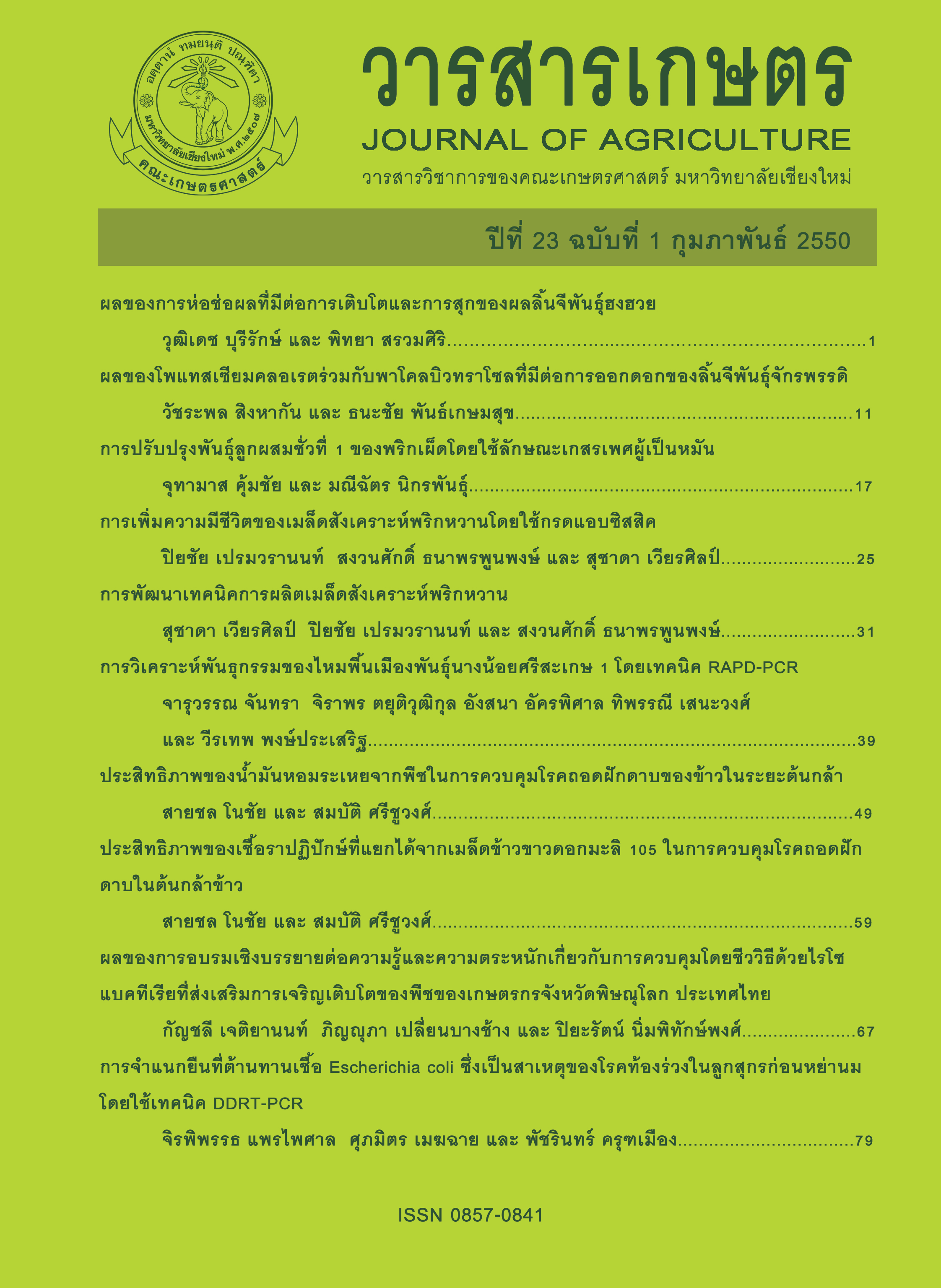ผลของการอบรมเชิงบรรยายต่อความรู้และความตระหนักเกี่ยวกับการควบคุมโดยชีววิธีด้วยไรโซแบคทีเรียที่ส่งเสริม การเจริญเติบโตของพืช ของเกษตรกรจังหวัดพิษณุโลก ประเทศไทย
Main Article Content
บทคัดย่อ
การใช้สารปราบศัตรูพืชอย่างไม่เหมาะสมเป็นปัญหาสำคัญสำหรับประเทศไทย เมื่อไม่นานมานี้ไรโซแบคทีเรียที่ส่งเสริมการเจริญเติบโตของพืช (พีจีพีอาร์) ได้รับการพิสูจน์แล้วว่า เป็นทางเลือกในการควบคุมโรคพืชที่เป็นมิตรต่อสิ่งแวดล้อมมากกว่าสารเคมี วัตถุประสงค์ของการวิจัยครั้งนี้เพื่อ (1) ศึกษาผลของโครงการอบรมที่มีต่อความรู้และความตระหนักของเกษตรกร และ (2) ศึกษาความสัมพันธ์ระหว่างปัจจัยพื้นฐานกับความรู้และความตระหนักของเกษตรกรเกี่ยวกับการจัดการและควบคุมศัตรูพืชด้วยพีจีพีอาร์ การวิจัยนี้เป็นแบบกึ่งทดลอง ตัวอย่างกลุ่มเดียว ทดสอบก่อนและหลัง ดำเนินการในจังหวัดพิษณุโลก การอบรมประกอบด้วยการบรรยายและอภิปรายร่วมกับการเยี่ยมชมแปลงสาธิต ติดตามผลที่ 1 3 และ 6 เดือนหลังการอบรม มีเกษตรกรเข้าร่วมในการวิจัยทั้งสิ้น 32 ราย ผลการวิจัยพบว่า การอบรมสามารถเพิ่มความรู้ของเกษตรกรได้อย่างมีนัยสำคัญ เกษตรกรที่มีอายุ เพศ ระดับการศึกษา และความถี่ในการใช้สารปราบศัตรูพืชมีการเพิ่มขึ้นของความรู้ใกล้เคียงกัน อย่างไรก็ตาม การอบรมไม่สามารถเพิ่มความตระหนักของเกษตรกรได้อย่างมีนัยสำคัญ ยกเว้นความตระหนักต่ออันตรายของสารปราบศัตรูพืช ความรู้ที่เพิ่มขึ้นของเกษตรกรมีความคงทนถึง 6 เดือนหลังการอบรม การศึกษาไม่ใช่ปัจจัยพื้นฐานที่ทำนายระดับความรู้และความตระหนักของเกษตรกร โดยสรุป การอบรมเชิงบรรยายสามารถเพิ่มความรู้ของเกษตรกรเกี่ยวกับการจัดการและควบคุมศัตรูพืชด้วยพีจีพีอาร์
Article Details
เอกสารอ้างอิง
Adesina, A. A. and M. M. Zinnah. 1993. Technology characteristics, farmers’ perceptions and adoption decisions: A Tobit model application in Sierra Leone. Agr. Econ. 9(4): 297-311.
Adesina, A. A. and J. Baidu-Forson. 1995. Farmers’ perception and adoption of new agricultural technology: Evidence from analysis in Burkina Faso and Guinea, West Africa. Agr. Econ. 13(1): 1-9.
Ajzen, I. 1988. Attitudes, Personality, and Behavior. Dorsey Press, Chicago. 278 pp.
Bacic, I. L. Z., D. G. Rossiter and A. K. Bregt. 2006. Using spatial information to improve collective understanding of shared environmental problems at watershed level. Landsc. Urban. Plan. 77(1-2): 54-66.
Black, A. W. and I. Reeve. 1993. Participation in landcare groups: The relative importance of attitudinal and situational factors. J. Environ. Manage. 39(1): 51-71.
Glick, B. R., C. B. Jacobson, M. M. K. Schwarze and J. J. Pasternak. 1994. Does the enzyme 1-aminocyclopropane-1-carboxylate deaminase play a role in plant growth-promotion by Pseudomonas putida GR12-2?. pp. 150-152. In: M. H. Ryder, P. M. Stephens and G. D. Bowen (eds.), Improving plant productivity with rhizosphere bacteria. Commonwealth Scientific and Industrial Research Organization, Adelaide, Australia.
Jetiyanon, K. and J. W. Kloepper. 2002. Mixtures of plant growth-promoting rhizobacteria for induction of systemic resistance against multiple plant diseases. Biol. Control. 24(3): 285-291.
Jetiyanon, K., W. D. Fowler and J. W. Kloepper. 2003. Broad-spectrum protection against several pathogens by PGPR mixtures under field conditions in Thailand. Plant Dis. 87(11): 1390-1394.
Kanato, M. 1998. Health risk associated with hazardous pesticide use among Thai agriculture workers in 30 rural communities. J. Clin. Epidemiol. 51(Suppl.1): 23S.
Kloepper, J. W., F. M. Scher, M. Laliberte and B. Tipping. 1986. Emergence-promoting rhizobacteria: Description and implications for agriculture. pp. 155-164. In: T. R. Swinburne (ed.). Iron, Siderophore, and Plant Disease. Plenum, New York.
Lapar, M., A. Lucila and S. Pandey. 1999. Adoption of soil conservation: The case of the Philippine uplands. Agr. Econ. 21(3): 241-256.
Office of Agricultural Economics. 2005. Economics and agricultural data (imported pesticides). (Online). Available: http://www.oae.go.th/ statistic/import/imPTC.xls (June 6, 2005).
Food and Drug Administration. 2004. Health risk assessment of agricultural workers using chemical pesticides. Ministry of Public Health, Nonthaburi, Thailand. 150 pp.
Morris, J., J. Mills and I. M. Crawford. 2000. Promoting farmer uptake of agri-environment schemes: The countryside stewardship arable options scheme. Land Use Policy 17(3): 241-254.
Raupach, G. S., L. Liu, J. F. Murphy, S. Tuzun and J. W. Kloepper. 1996. Induced systemic resistance in cucumber and tomato against cucumber mosaic cucumovirus using plant growth-promoting rhizobacteria (PGPR). Plant Dis. 80(9): 891-894.
Reece, J. D. and J. Sumberg. 2003. More clients, less resources: toward a new conceptual framework for agricultural research in marginal areas. Technovation 23(5): 409-421.
Rogers, E. M. 1983. Diffusion of Innovations. (3rd ed.). Collier Macmillan, London. 519 pp.
Schuck, E. C., W. Nganje and D. Yantio. 2002. The role of land tenure and extension education in the adoption of slash and burn agriculture. Ecol. Econ. 43(1): 61-70.
van Peer, R., G. J. Niemann and B. Schippers. 1991. Induced resistance and phytoalexin accumulation in biological control of Fusarium wilt of carnation by Pseudomonas sp. Strain WCS417r. Phytopathology 81: 728-734.
Wadsworth, J. 1990. Developing efficient extension strategies: Results of an experiment involving Costa Rican livestock producers. Agr. Syst. 34(3): 259-275.
Wei, G., J. W. Kloepper and S. Tuzun. 1991. Induction of systemic resistance of cucumber to Colletotrichum orbiculare by select strains of plant growth-promoting rhizobacteria. Phytopathology 81: 1508-1512.
Williamson, N. B., M. J. Burton, W. B. Brown, L. E. Baumann and R. J. Farnsworth. 1988. Changes in mastitis management practices associated with client education, and the effects of adoption of recommended mastitis control procedures on herd milk production. Prev. Vet. Med. 5(3): 213-223.
Zhang, S., W. Xu, Z. Yan and R. Mei. 1996. Research and commercialization of yield-increasing bacteria in China, pp. 47-53. In: W. H. Tang, R. J. Cook and A. D. Rovira (eds.). Advances in Biological Control of Plant Diseases. China Agricultural University Press, Beijing, China.


